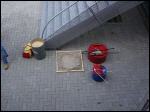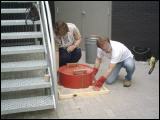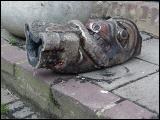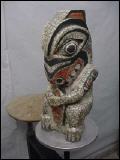Reduction
For the reduction we normally prepare a spot where we put a layer of sand. On the sand we put the reduction material. In general we take the wood chips that you buy in a pet shop for small animals. But you can try also something else. As soon as we feel that the temperature shock is sufficient we put the ware on the reduction material.
On one hand the ware must have its temperature shock; on the other hand it must still be hot enough to start the fire of the reduction material.

Than we put a large tin can or half a barrel over the ware like a top hat and press it into the sand. On the outside we press the sand against the barrel in order to keep the smoke under the barrel and away from the neighbours. Try to subject the ware to a maximum smoke density. Try different sizes of barrels of cans. A small piece under a huge barrel will not give you the smoke density/reduction effect that you are looking for. Do not keep the ware away from the smoke by burying it under the reduction material. The reduction effect is already done after a couple of minutes. You can remove the barrel but the temperature there may still be high enough to get the fire starting again. If you want to avoid any nuisance just wait longer until it has cooled off further. Then you can remove the barrel without any trouble.

During the reduction process it is also important to wear protective glasses. Ash that swirls up and gets in you eyes is very irritating. The ware itself will still be too hot to handle with your bare hands. So wear your gloves and use your tongs. If you are not satisfied with the reduction effect because it is grey instead of black you can place the ware back in the kiln and fire it to 600 – 700 °C. You will see that the reduction effect will fully disappear and you can do the whole reduction again. Especially when you do this more than once the ware will get more sensitive for cracks.

The description we just gave is just a basic firing procedure. There is of coarse a more to explore and to try out. A lot of different techniques and alternative firings can be found in the book Rakuvaria II by Ed & Ine Knops. You can order this book with us in the Dutch, English, German and French language.
Finally we wish you a lot of pleasure with raku firing and using our kiln.

(C) 2005 - All rights reserved